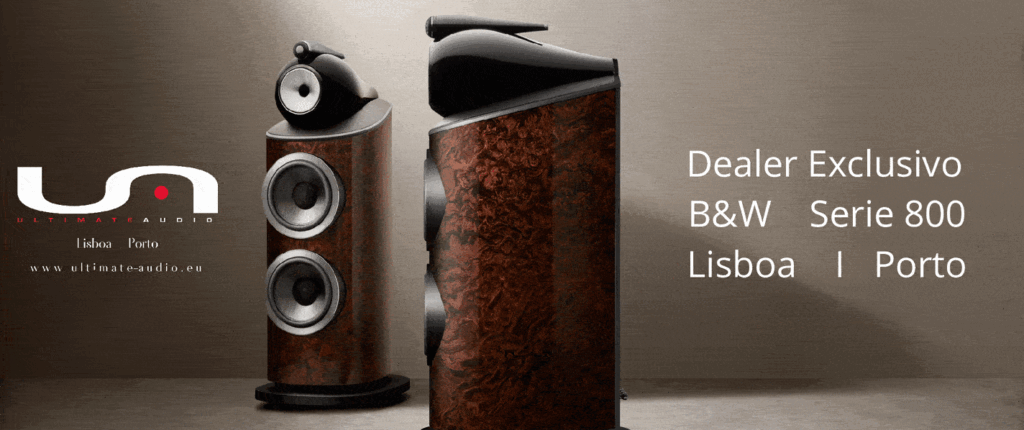This war I’m going to talk about is not between the houses of York and Lancaster, nor between Michael Douglas and Kathleen Turner in Danny DeVito’s 1989 film. It’s a battle between two streamers: the Denon DNP-2000NE and the Eversolo DMP-A6 Master Edition.
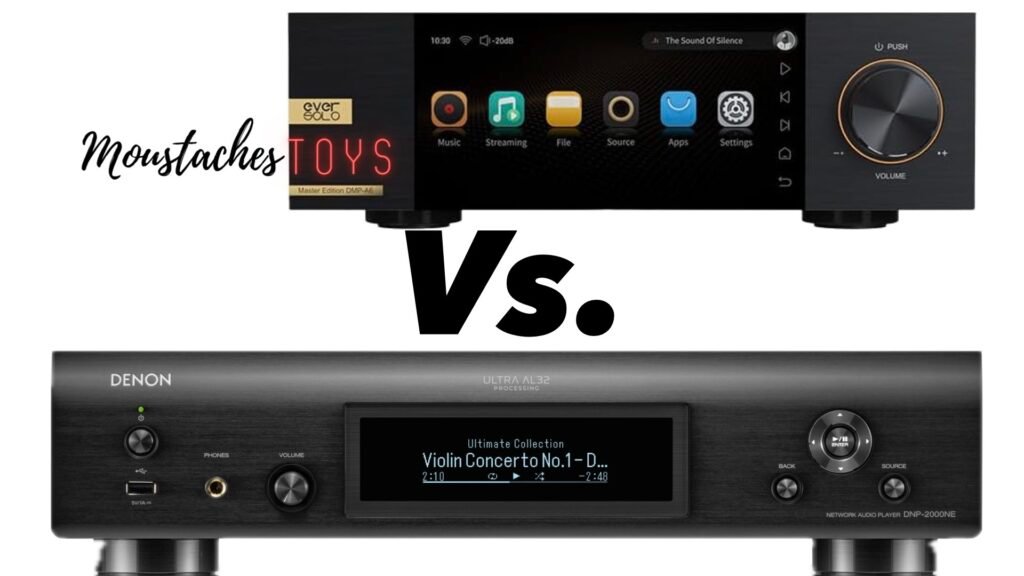
In “The War of the Roses”, Michael Douglas and Kathleen Turner are a couple who gets involved in a war of the sexes. This article will also focus on marriages, or, if you prefer, on the synergies between equipments. The Eversolo could be the perfect example for a case study on good or bad ones. I tested this most fashionable streamer with three different integrated amps: a class A tube amp (Audio Note Cobra, review here soon) and two transistor amps, one class AB (Serblin & Son Frankie EX) and one class D (Axxess Forté 1). The marriage was perfect in one case, so-so in the other, and, in my opinion, avoidable in the third. But first:
In a network player, the user interface can be as important, or more so than the sonic performance. Even because the sonic deltas may be narrow, very narrow. I remember a small integrated amp with a network player that came here a few months ago, which sounded quite reasonable to me (very reasonable for the price, and for everything it proposes), but where the network player module, together with the BlueOS app, made me forget any eventual fragility – the NAD C700.
Now, we’re going to analyze and compare the network player that everyone already talked about (I was the only one missing…), the Eversolo DMP-A6, here in the Master Edition variant, and the Denon DNP-2000NE. Respectively offered for around €1300 and €1600. And incidentally do it head-to-head.
Starting this analysis with the Denon
The DNP-2000NE is Denon’s top-of-the-line network player. It can function as a preamp if the sources are exclusively digital, as it has a variable and a fixed output, as a network player, as a DAC, or as a headphone amp (6.3mm jack in the front panel). It can be controlled by the remote control or the HEOS app. It also has an HDMI arc input to connect directly to the TV, allowing the use of only one remote. It can also be controlled via Apple’s Siri or Amazon’s Alexa. It also supports Bluetooth and AirPlay. AirPlay wakes the Denon from standby, no more. In terms of build quality, you can see, also from the 10kg weight, where the money from the specifications was used for, on the inside. The front panel has a black background with white information, easily readable from my almost fifty-year-old sweet spot, more than 2.5 meters away. At the back, in addition to the two antennas for Bluetooth and Wi-Fi, we find the power cord socket, the variable or fixed RCA outputs, two optical inputs, one coaxial, and one USB, two outputs for an external DAC, one coaxial and one optical, RJ45 network input, HDMI arc socket and Trigger to integrate with the brand’s integrated amp. We also learn that the Denon is made in Japan, which ends up enhancing the pride of ownership. The converter works with two ESS DAC chips per channel, with error correction, already in the analog domain. The HEOS app allows you to use Tidal, SoundCloud, Spotify, Napster, TuneIn, Amazon Music, internet radios and hard drive (or NAS) natively. Note the lack of Qobuz.

The Eversolo
Also under review here was the Eversolo DMP-A6, in the Master Edition version. It is also a network player that can function as a preamp for digital sources, as it also has volume control. Just like the Japanese player, we can listen to music via internet radio or install music streaming apps natively in the Eversolo Control app. The difference here is that we can additionally run Qobuz natively (The Qobuz search function within the Eversolo app found what the original French app ignored). The Eversolo can also house in the existing slot underneath a 2.5” SSD hard drive up to 4TB, or if we have an incompatible external one, or a computer via USB on the rear panel. The front houses a touch screen, allowing direct control on the device along with the volume knob, or via the app (as I always used whenever I didn’t use Apple Music, installed directly on the Eversolo). The two different user interfaces via phone or touch screen can increase the length of the learning curve. This screen also allows the viewing of VU meters, with 4 different graphics available, for those who appreciate this kind of thing. Both on the Denon and on the Master Edition, I always preferred control via their respective apps. The exception was using the Apple Music app in the user interface available on the Eversolo’s touch screen.
In terms of footprint, the Eversolo has what I call half-width, or shoe box size, and only 1/4 of the weight of the Japanese cousin. Here the project money went not only into the internal components, but also into the materials used for the exterior, and it even looks more expensive than it really is. I would venture to say that it appears to be more expensive than the Denon, due to the choice of more noble materials for the exterior. At the back, we have a power button, in addition to the power cord socket and the network cable input. We also have an HDMI output, a USB output for the possibility of being used as an external DAC, and a USB socket for a hard drive or computer. Analog RCA or balanced outputs, coaxial, optical and USB-C digital inputs and coaxial and optical outputs. Two Wi-Fi antennas and one Bluetooth. My home network is going through a bad time, and despite having only two antennas (versus three on the Eversolo), the Denon proved better stability, never once hiccuping. The EverSolo is made in China, and the converter is dual mono with two ESS DAC chips.
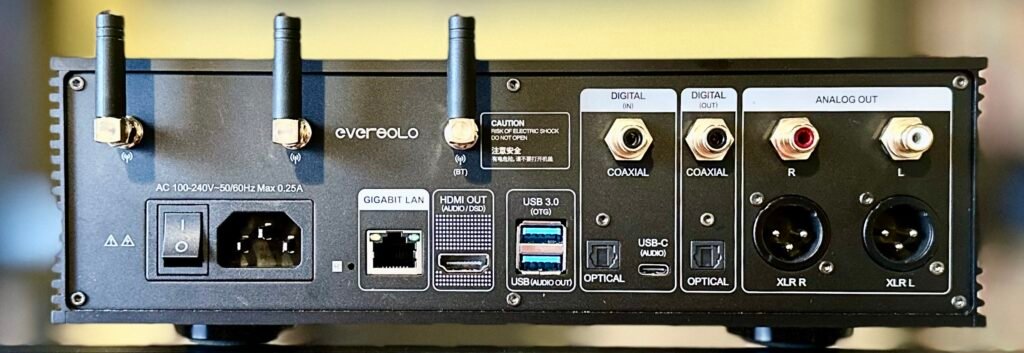
Important! The user interface.
In day-to-day use, we all seek simplicity and ease. How do I use a streamer? Most of the time via cell phone. And most of those times, I stream what I want to hear via AirPlay. Why? Because it’s simply the easiest way to use it. When do I normally not use AirPlay? In critical listening mode. Who does critical listening, and in this price range? And how often? – Just like in a car, even though we can’t drive faster than 50 or 120 km/h, we like to know that it can go a little faster…
Connecting and setting up the Denon was as simple as… very simple! I paired the DMP-2000NE with the phone on the same network and that’s it. On the EverSolo, I took the normal route in these things: enter the home Wifi password, and it’s rolling too with ease. As simple as the best software on the market. HEOS is just faster and easier. With the EverSolo Control and HEOS (for Denon) apps installed, let’s explore. HEOS doesn’t allow you to natively stream Qobuz, but we always have Tidal, Deezer, Amazon, Soundcloud, etc. Qobuz works via AirPlay. EverSolo Control includes Qobuz, Tidal, Highresaudio, Amazon Music, Deezer, Soundcloud and others natively. And it still has a card up its sleeve: the ability to natively install Apple Music. The Denon wakes up from standby at AirPlay’s request, the EverSolo already has to be turned on.
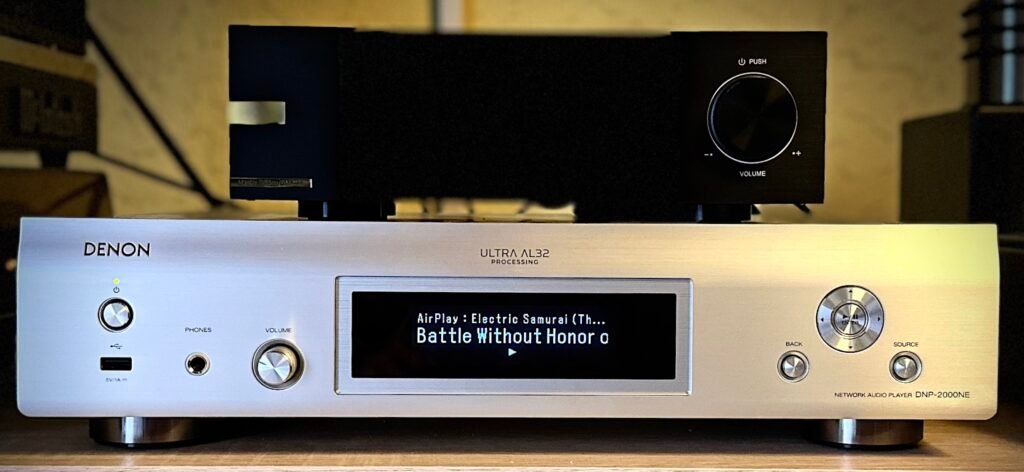
What I was listening to:
When these streamers arrived at Torre Bigodes, the Axxess Forté 1 was still here for review, an all-in-one class D integrated amp from Audio Group Denmark. An amplifier costing €5,000 to the happy owner. I mention the price because I’ll end this review with another integrated amplifier, costing around €5,500, but tube-based and class A. Since I’ll be using three amplifiers, one class D, one class AB, and the last one class A, for a matter of head-to-head, I always used the analog outputs from the EverSolo and the Denon.
At the first chords with the EverSolo as the source, using the streamer’s converter, I quickly realized that this marriage suffered from, as we say in English: “too much of a good thing”, with both equipments vying to radiograph the tiniest detail contained in the music.
The Chinese network player arrived with a reputation for slaying giants. In times of fast and easy content consumption, where clickbait reigns, David will have defeated a series of Goliaths. This David, like in Michelangelo’s statue, where even the veins appear protruding in the marble, aims to be an ode to the fanatic search for photographic and hyper-realistic detail. Michelangelo’s David, transported to the 21st century, would be a lean and muscular guy. Just fiber, full of strength. Subjected to a life of salad diets, white meats and gym. Now the Danish amplifier, which has Viking genetics, but which will have received the education and mannerism of the best British boarding schools, did not combine in the best way with the Chinese. The EverSolo, like any other sound reproduction equipment, is dependent on symbiosis, with the upstream and downstream equipment. I’m not saying that everything seemed perfect to me, if I hadn’t confronted it with a rival, and experimented with other amplifiers. Review stuff, only possible to replicate in a store.
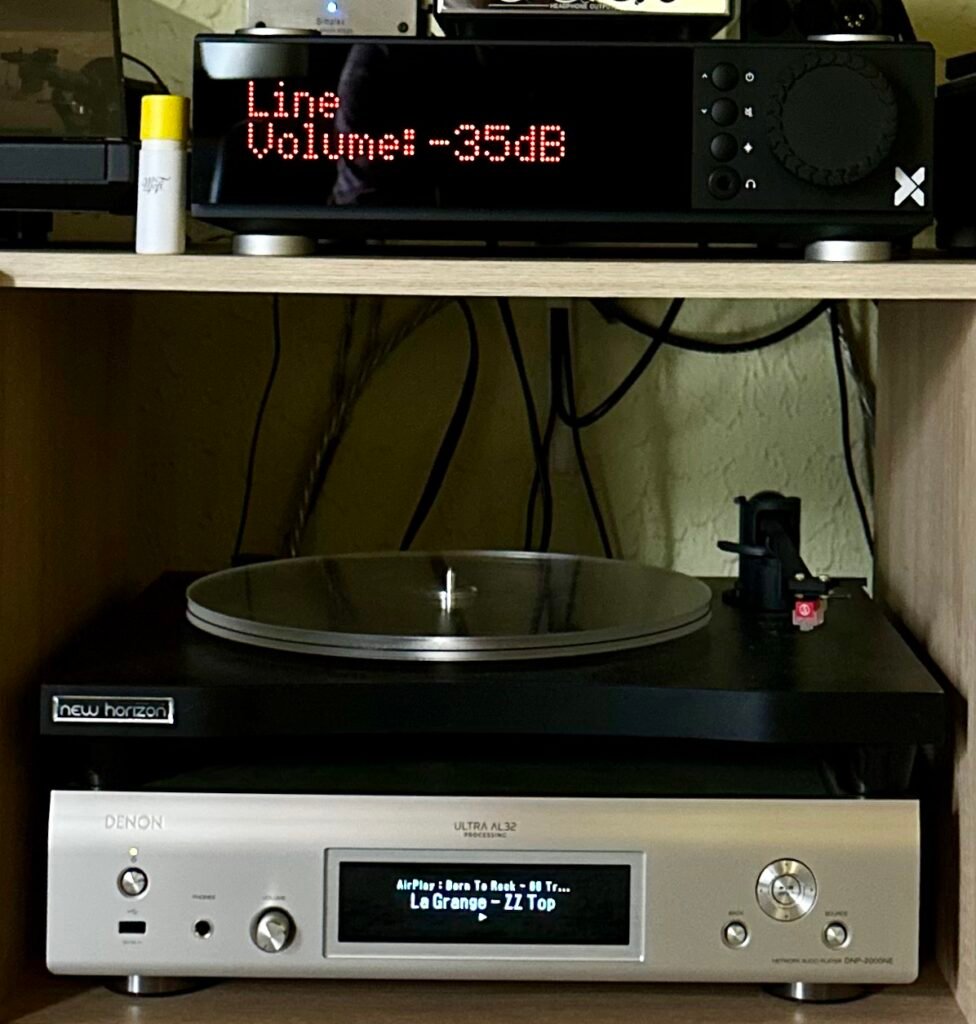
“Know How” by Kings of Convenience: The melody fills the room. The huge stage. The duo, here accompanied by Feist’s voice, enchant with the melody and sweetness of the music, fill the room with musical honey and dark chocolate, with the perfect definition of texture and position of each instrument and vocalist. The Eversolo, with the Axxess Forté 1 integrated and the Alacrity Audio Dundee 5 speakers, knits a sound stage with such width and depth that it becomes almost hypnotic. Everything seemed perfect to me on the Eversolo. I switched to the Denon. Immediately some loss of the “radiograph” effect is noticed. However, everything seems more of an ensemble, which somehow seems to make more sense. It’s more of a band, less of a group of musicians.
“Russians” by Sting, does anyone remember? I do! From the black cloud that loomed over our heads, from the perception of constant threat, even for the age I was then. Black cloud that apparently seems to be back. What strange times we live in… on the Master Edition I heard every detail. Every tick, every touch of the clock that in this song symbolizes the path to Zero Hour. On the Denon this song loses micro-detail, but gains density, emotional charge. As if Sting’s message from his ex-Police days weighed more heavily on my shoulders.
“Jóga” by Björk is an authentic vortex of sonic landscapes, with complex orchestral arrangements, keyboards, programming, studio machinery, drums, bass, etc., perfectly analyzed and explained by the EverSolo. Here, the Denon had more difficulty, and reproduced something more towards a homogeneous mass of sound.
Let’s move on to class AB, with the Frankie integrated amp from Serblin & Son.
“Sign O’ The Times” by Prince, more body in the Denon. There’s that greater density and scale that I had already heard with Sting. The EverSolo achieves better separation. The bass with more body and impact on the Denon, but greater definition and texture on the Master Edition. I didn’t know Prince’s live voice, but the timbre on the Denon appears to be more realistic. Everything I had already observed in class D is confirmed, just with less stage, scale and micro-detail.
It is on “Geyser” by Mitski that the Denon demonstrates its scale and muscle. We are attacked by an avalanche of sound that when it hits us, despite its density and weight, does not bury us.
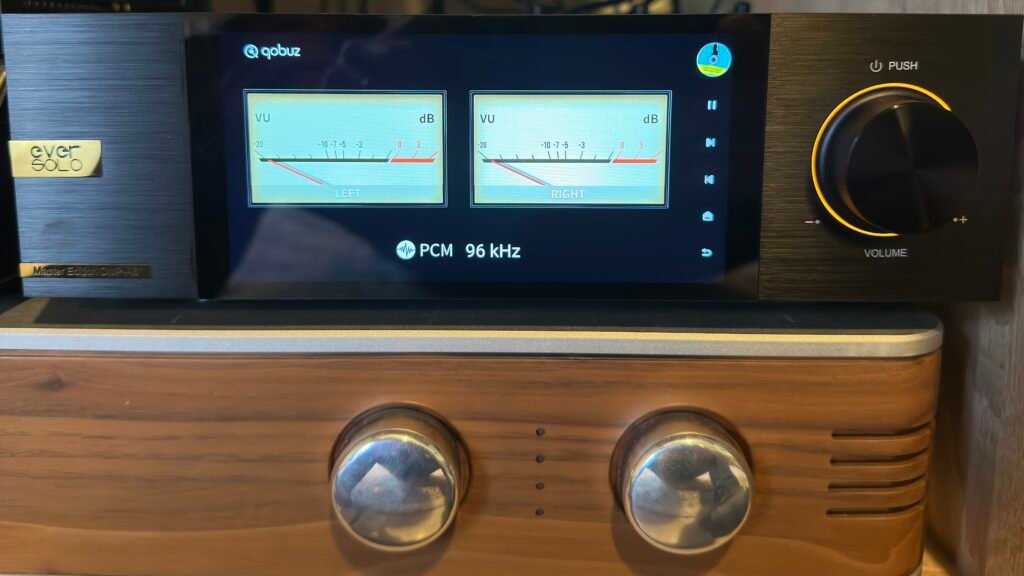
It’s time to try them with the Audio Note Cobra, class A tube integrated.
“Cornflake Girl” by Tori Amos. Amos’ voice more dramatic on the EverSolo, due to the greater micro-detail and texture, instruments with more attack. The Denon is rounder.
“Para os Braços da Minha Mãe” by Pedro Abrunhosa & Comité Caviar, here in a duet with Camané. Anyone who doesn’t wring inside when listening to this song may have a granite block instead of a heart inside their chest. This song says a lot to many of us portuguese, even to me who, in a rare case, have no immigrants in my family. And, Magic!! The Denon served this emotional dish with the recognized quality of the portuguese national cuisine ingredients (in this case musical ingredients), but plated in that way that only the Denon seemed to achieve, where all the dots connect, everything fits. On the Eversolo, the musicians and vocalists were here in the room, in an even more focused way, and with a greater sense of depth, but the Denon seems to play on a slightly higher level in the organic appeal of the music. On the other hand, the fleshy character of the Audio Note seems to favor the Chinese player and its ability to radiograph the music. Here the delta between Denon and Eversolo becomes just a matter of each one’s taste.
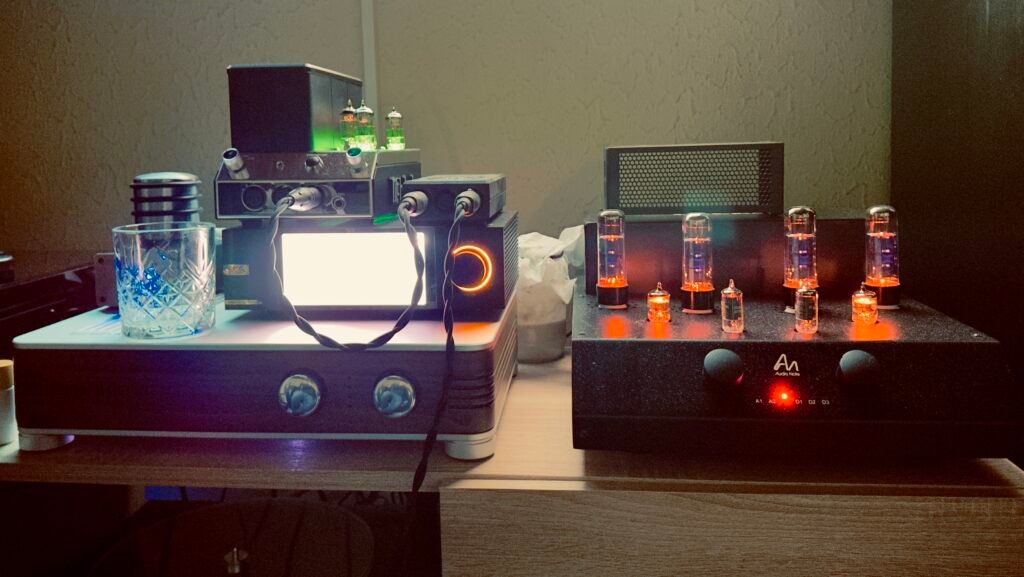
The Denon sound in summary:
The Denon denotes good focus and superior sibilance control compared to its Chinese cousin. On the other hand, despite having a more physical character than the rival tested here, the bass showed less definition and texture compared to the Master Edition’s. The sonic approach proved more relaxed than on the Eversolo. It formed a good symbiosis with the transparent and muscular character of the Forté 1. Curiously, not so much with the Frankie. Its “all-terrain” posture also helped with the Cobra, although in this case I didn’t definitively decide which player I preferred to listen to this amplifier with. In each song, a different judgment.

The EverSolo Master Edition sound in summary:
The EverSolo’s sound stage is wide and with reasonable depth. The bass attack is powerful, defined and textured, although with less scale than on the Denon. The midrange and highs are the strong point of this player with the right equipment. The detail is fine, as is thin its sonic signature, and lacks some gusto, to some extent. It deserves some care when combined with other equipment. The marriage with the Cobra was undoubtedly happy! The rounder character of the class A tube amp have softened the sharper edges of the Master Edition.
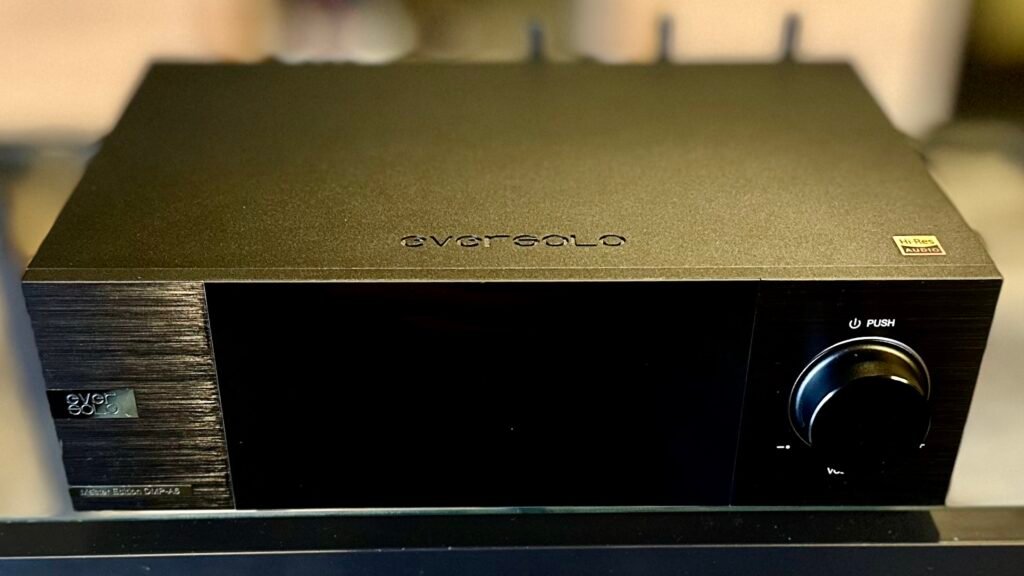
Where does this leave us?
Either of these players will perfectly serve to boast to our friends about the great deal you just closed after the purchase, as both offer much more than they cost, both in functionality and sound quality.
The Eversolo looks with its nobler visible materials, and features, and the high-resolution touch screen will continue to win over fans, and will continue to sell like hot cakes. Like a good Japanese, the Denon preferred the money well spent where the eyes don’t reach, on the internal components. The 10kg weight and the way it behaved with my poor Wi-Fi network are an example.
In purely functional terms, the Eversolo may be one step ahead due to its slightly easier user interface, and by running Tidal, Qobuz and Apple Music natively. The lack of native Qobuz integration on the Denon’s HEOS app is a detail that I hope is corrected soon.
Up to this point it appears that the Chinese player will take the victory home on this head-to-head (albeit by a slim margin) but, … go slowly with that. A streamer is more than a hub to listen to music from digital sources. The magic words are: LISTEN TO MUSIC. Anyone who has followed any of my reviews already knows that I don’t believe in giant slayers, and here the Chinese, although shooting well above its proposed price in sound quality, may be a complicated marriage with equipment that can reveal the thin character of its sound. In critical listening, and married to an amplifier that is a transparent showcase, it can become an eventually less rewarding experience than so many influencers promised it would be. The sauce may end up too appetizing, or the dessert too sweet. Just like in Danny DeVito’s movie, between the characters played by Michael Douglas and Kathleen Turner. But with the Cobra’s class A tube amp, with its round and fleshy character, there you have it, it married like ham and melon.
The Denon is more off an old timer: “Color touch screen? – That’s just noise!”. It has a full chesty sound, with a very interesting sonic scale and imprinting a somewhat more organic touch to the music than its Chinese rival. Above all, it proved to be an all-terrain, and handled with excellence everything I threw at it. I found myself listening to music, in long sessions, only interrupted by external reasons or the advancing of the hours, and never thinking: “would this music play better with the Eversolo?”. With the Master Edition, however, I sometimes found myself wondering precisely if the Japanese rival wouldn’t play this or that track better.

Eversolo DMP-A6 Master Edition specifications
Display
6″ LCD touchscreen
Internal Memory
4GDDR4 +32GeMMC
DAC
ES 9038Q2M*2
Audio Processor
XMOS XU316
Op-amp Chip
OPA1612
Power Supply
Low noise, high quality switching power supplies
SSD
M.2 NVME 3.0 2280 protocol, up to 4TB
USB-A Port
USB3.0*2
Ethernet
RJ-45(10/100/1000Mbps)
WiFi
WiFi 2.4G+5G dual band
Playback and DAC Decoding
Support up to stereo DSD512, PCM 768KHz 32Bit, MQA
Music Service
Tidal, Qobuz, Highresaudio, Deezer, Paradise Radio,WebDAV, UPnP
Streaming
Air Play, DLNA, Tidal Connect, Qobuz Connect etc.
Bluetooth Audio Input
BLuetooth BT5.0, support SBC/AAC
USB-C Audio Input
USB-C Audio Input:Supports Windows (10, 11), Android, IOS.
Support up to stereo DSD512, PCM 768KHz 32Bit, MQA
Optical/Coaxial Audio Input
Support up to stereo PCM 192KHz 24Bit, DSD64 Dop, MQA
Optical/Coaxial Audio Output
Support up to stereo PCM 192KHz 24Bit, DSD64 Dop, MQA
HDMI Audio Output
DSD64 Native multi-channel/PCM192KHz multichannel raw output(Up to 5.1)
Control Method
Mobile App,Touch screen control
XLR Output Audio Characteristics
Output level: 5.2V
Frequency response: 20Hz~20KHz(±0. 15dB)
Dynamic range: > 128dB
SNR: >128dB
THD+N: <0.00009%(-120dB) @A-wt
Crosstalk: >-125dB
RCA Output Audio Characteristics
Output level: 2.6V
Frequency response: 20Hz~20KHz (±0. 2dB)
Dynamic range: > 124dB
SNR: >124dB
THD+N: <0.00011%(-119dB)@A-WT
Crosstalk: >-124dB
PSU
AC 110~240V 50/60Hz
Rated Power
13W
Dimensions
L 187mm* W 270mm* H 90mm
Packing List
Power cable*1, USB cable*1,Screwdriver*1,user manual*1
Denon DNP-2000NE specifications
- DAC IC: 4x ES9018K2M, ESS Mono-Mode
- Dual Clock: Yes
- Digital Filter: Ultra AL32 Processing
- Noise Shaper: ES9018K2M
- Frequency response: DSD:2Hz – 50kHz; PCM(44.1kHz):2Hz – 20kHz
- Dynamic range in dB: DSD: 112dB; PCM: 118dB
- Signal-to-noise ratio in dB: DSD: 120dB; PCM: 118dB
- Total harmonic distortion: DSD: 0.0006%; PCM: 0.0008% (24bit)
- Headphone amp: Yes
Equipment in this head-to-head
- Streamer Eversolo DMP-A6 Master Edition,
- Streamer Denon DNP-2000 NE,
- Integrated amplifier Axxess Forté 1,
- Integrated amplifier Serblin & Son Frankie EX,
- Integrated amplifier AudioNote (UK) Cobra,
- Headphone amplifier McIntosh MHA200,
- Headphone RAAL Requisite CA-1a,
- Floorstanding speaker Alacrity Audio Dundee 5,
- Floorstanding speaker PMC Prodigy 5,
- Monitor speaker Indiana Line Diva 252,
- Monitor speaker Triangle Borea 03,
- Cabling and power distributor Ansuz,
